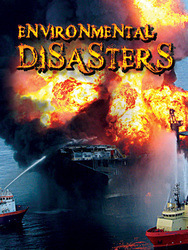Environmental Disasters
By Shirley Duke
Rourke, 2012 (available now)
ISBN #978-1-61741-784-9
Grades 4-6
Nonfiction
"In 2010 an explosion shattered a quiet April evening in theGulf of Mexico. Flames roared into the air on the Deepwater Horizon offshore oil platform. Startled workers scrambled to escape. Most of them reached safety. Millions of gallons of light crude oil gushed from the site."
After writing a report on fires in 7th grade, my interest in disasters grew, along with learning the science of them. It's interesting that I ended up writing this book. It followed Enterprise STEM and Forces and Motion at Work, and it was fascinating to research. I learned much more about our environment and the charge we have to keep it healthy. The most interesting part of writing this book was revisiting the history of some disasters that had happened in my younger days.
Each section in Environmental Disasters relates the situation about how the disaster happened, explains the consequences, and tells what may prevent it in the future. The book opens with the Deepwater Horizon oil spill. It goes on to discuss solid wastes like those at Love Canal and the problems with plastics and electronic wastes, nuclear meltdowns here, in Chernobyl, and Japan, acid rain, and the ozone. It includes a chart of small changes children can make to get involved in making the Earth safer. Each chapter includes diagrams that illustrate new vocabulary and more details about the processes involved.
The book has bright photographs with captions containing pertinent information not included in the text. It has a glossary, websites, and index, and an about the author section.
Activity 1
Look up information about the Chernobyl nuclear meltdown, the Three Mile Island disaster, and the more recent Japanese reactor problems following the tsunami. Use a Venn diagram to contrast and compare two of those disasters and their results.
Activity 2 (easier)
Make a timeline of disasters and display it. Use the book's information to begin and find others to include.
Find more disasters at this site.
National Science Standards: matter and its interactions; human impacts on Earth systems








Shirley Smith Duke's Blog




